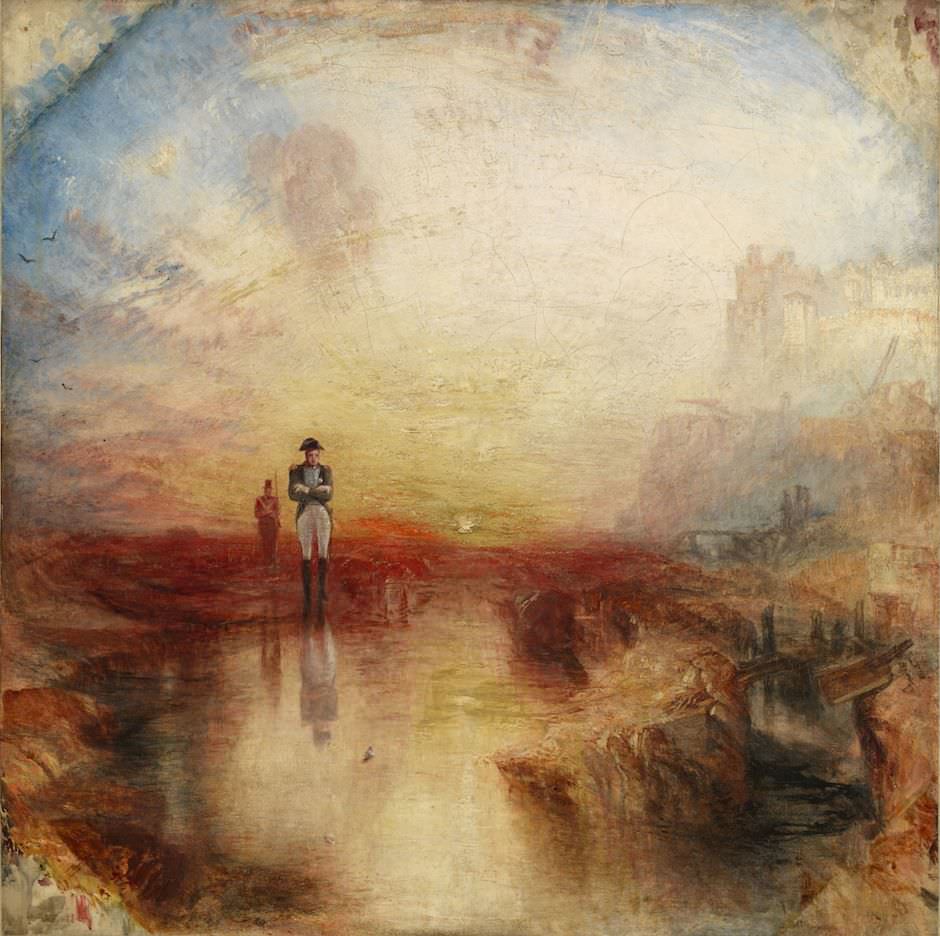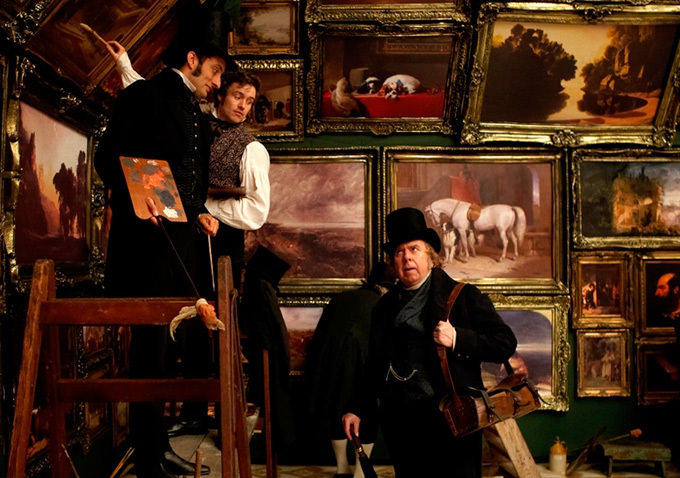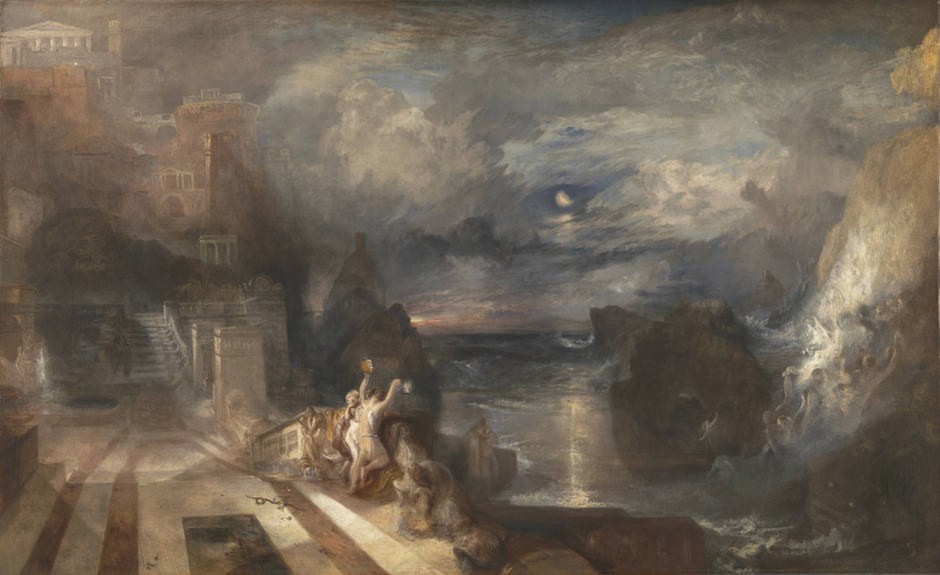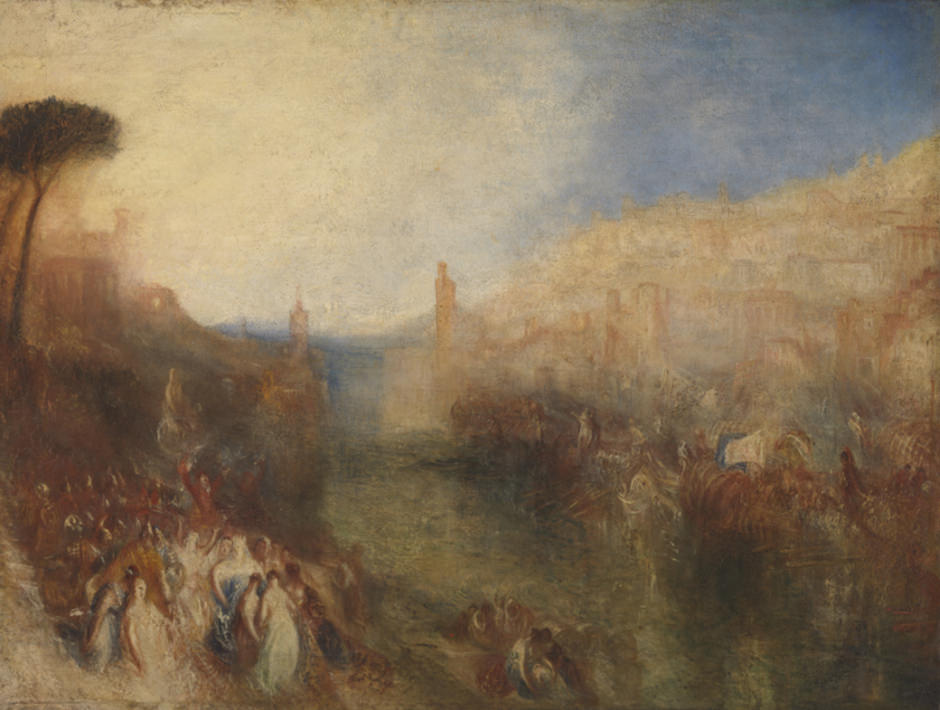The clocks in Britain have gone back an hour. It’s dark by tea-time now, but late October saw a bizarre return to summer with leaves turning gold under misty blue skies. It seemed entirely appropriate to walk across a sunlit London street to Tate Britain and into the bursting, glowing light of this exhibition of J.M.W. Turner’s late work: amber visions of Venice, drifting on its lagoon; blue-shadowed mountains; Claude-like myths under Mediterranean skies. Yet the coming storms are on show too—wild winds and rough seas, murky clouds over the brown English Channel. And now, of course, it’s raining.
Late Turner: Painting Set Free is a fittingly autumnal show, focusing on Turner’s life from his sixtieth birthday in 1835 to his death in 1851. At sixty, Turner was both admired and ridiculed, his work leaving critics and spectators baffled and sometimes angry. Many saw his shimmering canvases as a crazed denial of familiar rules. Was his eyesight failing? Was he going mad? Some of today’s twenty-first century visitors look pretty bewildered too. The rooms are packed, with people edging politely around one another and putting on their glasses to read the labels, anxious to be told what they are seeing. There’s a rather unnerving air of reverence, as if we know he is “great” and must nod respectfully even at the oddest works. Nothing new here—Turner was deliberately allusive, and elusive, and will always remain so. He kept Ruskin guessing when he asked the meaning of War: The Exile and the Rock Limpet (1842), with its elongated Napoleonic figure, throwing out hint after hint, but leaving poor Ruskin none the wiser. You can almost feel his glee.
Turner’s willful “difficulty,” as an artist and a man, powers Mike Leigh’s film Mr. Turner, which was also released here this fall (and will be released in the United States in December). Seeing the exhibition and the film together is like watching a strange, exhilarating conversation. And what a fine film it is: rich, enjoyable, imaginative, faithful to Turner’s spirit. Steering clear of familiar biopic clichés, it slides between modes like a Dickens novel, from the psychological depth of the central characters to jovial party scenes at Petworth and Punch-like caricatures of catty, competitive Royal Academicians. (The only jarring note is an irritatingly silly, simpering Ruskin.)
Timothy Spall’s magnificent Turner is an inarticulate, growling figure, muttering and grimacing, yet always conveying the artist’s burning ambition and yearning, suggesting the passions beneath the gruff exterior. Huffing and puffing, overweight and shabby, touchingly loyal to his old Dad, a Covent Garden barber who became his invaluable assistant (superbly played by Paul Jesson), he is still fighting the demons of his childhood, the horror of his mentally ill mother, carted off to Bedlam. We see his ruthlessness in his spurning of his former mistress Sarah Danby and their two daughters, and in his brusque treatment of Sarah’s niece Hannah, his awkward, psoriasis-scarred housekeeper, given an intensely touching performance by Dorothy Atkinson. Although the film does not show the erotic drawings that Ruskin burnt in horror after Turner’s death, we glimpse the lusty sexuality that placed him in a vanished Regency age at odds with Victorian propriety. In his last years, however, he found companionable refuge in Chelsea with his former Margate landlady, Mrs. Booth, brought to chirpy and tender life by Marion Bailey.
Leigh’s direction takes liberties with time and setting—as Turner did, moving the buildings of Venice around—but I missed the sense of Turner’s precision, his scientific honing of technique through years of experiment, seen at the Tate in every aspect of his work, from his choice of watercolor paper to the new formats of the 1840s—tondos, octagons, circles within squares. But I relished Spall’s ability to convey Turner’s invention and energy, jabbing at canvases, mixing spit with the paint to create a shimmering blur, mocked in the music halls for using egg yolk and jam. His Turner is a driven man, brave in the knowledge of his own genius, and in this reading it seems right for the film to dramatize Turner’s claim (never confirmed) that he lashed himself to a mast to experience a storm at sea—a perfect image of the artist breasting critical gales while embracing elemental turbulence, drunk with risk.
The Tate show plunges us into a similar whirl of motion, the restless travels of a man who refuses to be old. Longing to be “on the wing,” each summer until his mid-seventies Turner headed for Europe: to Italy, France, Belgium, and Germany, to Venice and Switzerland, filling sketchbook after sketchbook with pencil drawings and color-wash sketches. The world seems to turn with him in the spirals and vortices of his compositions. Day flashes into night in his ravishing Venetian nocturnes on velvety blue paper and in dramatic oils like Rockets and Blue Lights (1855) or The Parting of Hero and Leander (1837).
Advertisement
Contrary to myth Turner did not paint for himself in these last years; he was hungry for public acclaim and rich patrons. The Tate curators are keen to stress his engagement with modernity—in his trains and steamships, fires at the Houses of Parliament and the Tower, in A Disaster at Sea (1835) and the whalers amid the ice-floes (aimed at the purse of Elhanan Bicknell, sperm-oil mogul). True, yet these topical scenes are also variants on his enduring theme of human smallness in the face of nature and time. The same applies to his late canvases of classical myths and wars, Biblical scenes, moments from European history. He had always sought recognition as a history painter, the “high art” of the eighteenth century, and the argument of the Tate show and fine catalogue is that these paintings were designed as lessons for the modern world. Yet they feel laden with more private obsessions: with transformation, in the scenes from Ovid; with longing and loss and death; with rejection and exile, in Cicero gesturing at the mountains; with the fatal lure of light, in Regulus—the Roman general who, eyelids cut off by the Carthaginians, is blinded by the fiery sun.
At the end, the art world turned away from Turner’s near abstraction to German hyper-realism and the dawning Pre-Raphaelite movement. Mr. Turner is immaculate in depicting this, showing Turner’s gallery mirroring the artist’s decline, as cobwebs spread over his stacked canvases and water drips through the roof. Amid this decay he still stubbornly turns down a fortune for all his works, preferring to leave them to the nation. In a surprising, jolting scene early in the film, Spall’s Turner stumbles hesitantly, out of tune yet powerfully determined, over Purcell’s setting of Dido’s lament “Remember me, Remember me—but oh, forget my fate.” It is moving to find that at the Tate, the final works are not the great, hazy semi-abstracts like Norham Castle (circa 1845)—to me, a painting of memory itself—but his three paintings of Dido and Aeneas, ending with The Departure of the Fleet (1850) as Aeneas returns to Rome. Turner, too, was epic in his scope—yet surely, despite his disappointments, he was no Dido sidelined on the shore, rather a painterly Aeneas, an artist Virgil, founding a new empire of art.
Late Turner: Painting Set Free is showing at Tate Britain, London, through January 25, 2015; it will be at the J. Paul Getty Museum, Los Angeles, February 24-May 24, 2015 and at the de Young Fine Arts Museums of San Francisco June 20-September 20, 2015.
Mike Leigh’s film, Mr. Turner, is now playing in the UK and will be released in the US on December 19.







